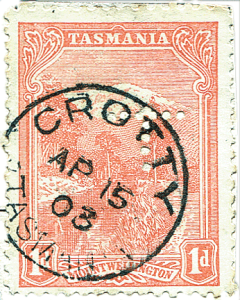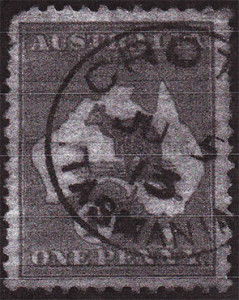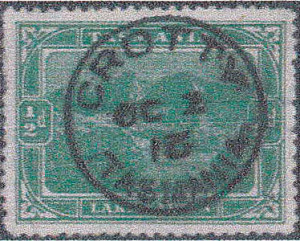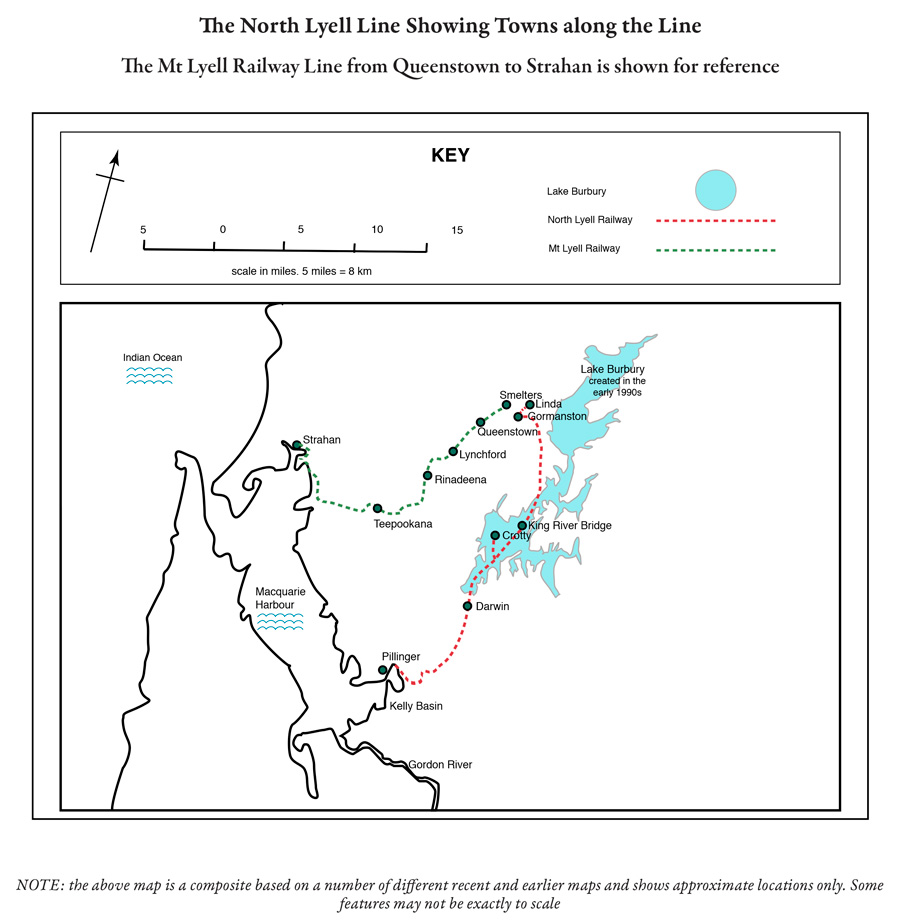CROTTY : ITS HISTORY, POST OFFICE, POSTMASTERS AND POSTMARKS
John Campton (Originally published in The Courier Dec 2016 Edition 60)
Crotty Western Tasmania Postal History: – in this issue we will continue our visitations of old Tasmanian West Coast post offices. We have momentarily bypassed the larger and still existing post offices of Queenstown and Zeehan to look at Crotty. North Mount Lyells’ high quality ore gave Crotty the potential to rival Queenstown and surpass Zeehan but a series of unfortunate circumstances and poor management led to its demise. We hope you enjoy this in depth investigation which has in part revised some of the information on Crotty in the Green Books.
POSTMARK
Crotty type 1 cds. Lancaster rating R, Hardinge rating: 8# R Rare with good strikes harder than usual to find. This was the only cds to be used at Crotty.
-

-
Crotty Type 1 CDS on T-perfin 1d Pictorial
-

-
Crotty Type1 from the late period dated 5 Jul 1913
-

-
Crotty Type 1 from the Late period dated 2 Oct 13
THE POST OFFICE
Crotty Western Tasmania Postal History
The Telegraph and Money Order office opened at Crotty on 8th January 1902 and the post office opened 1.4.1902 and closed 30.11.1911. Early date for the cds during this period is 18.4.1902, and late date 31.8.1911. The post office was downgraded to post office only status late 1903 due to Crottys’ demise.
Crotty post office reopened 5.6.1913 but closed shortly thereafter on 31.5.1914. The old cds was reissued and only five copies are known from this second period and are rated 5R. Early date for the cds in this period is 5.6.1913 and late date 11.12.1913.
Revised Postmasters as per Green Books and Trove:
· 1.4.1902 – September 1907: Mr. W. H. Westgarth (a local, died at Queenstown October 1908. He was also the postmaster at Montezuma 1900 – 1902),
· October 1907 – November1908: Miss Agnes E. Turvey (teacher),
· December 1908 – early February 1909: No postmaster,
· Early February 1909 – Mid May 1910: Miss Esther V. Dineen (teacher),
· Mid May 1910 – Early April 1911: Mrs. Ward (wife of a resident Mr. E Ward),
· Early April 1911 – 30.11.1911: Mr. Nelson. O. Ives (teacher),
· 31.11.1911 – 4.6.1913: Post Office closed,
· 5.6.1913 – December 1913: Mr. Fred Shackcloth (teacher),
· January 1914 – 31.5.1914: Unknown or possibly unmanned.
Mr Nelson Ives was at Crotty for “eighteen months” departing Crotty October 1911 to “take charge of the Renison Bell school”. As he was also the postmaster at that time we assume his transfer precipitated the closure of the Crotty post office for the first time the following month as a replacement could not be found.
Fred Shackcloth, “a Longford native” passed his examinations for “provisional teacher” in September 1912 and we assume Crotty was his first posting late 1912 or even early 1913. Crotty had no postmaster on his appointment as the post office was closed. The Green Books note him as postmaster in 1912 but this was not possible as the post office was closed all 1912.
Fred Shackcloth was the postmaster during the second period of opening 5.6.1913 – 31.5.1914. With a normal posting period being at least a school year Fred Shackcloth’s departure from Crotty could have been around the end of 1913 assuming he was there from the start of the school year till its end.
The smelting, electrical and rail sidings at Crotty were dismantled in an ad hoc fashion over a number of years. Increased dismantling activity and with a school teacher to second as a postmaster may have led to the post office being opened for the second period. There is anecdotal evidence that the Crotty smelters were further dismantled in this period with the local newspaper noting that Claude Counsel broke his arm dismantling the smelting works in December 1914.
Fred Shackcloth enlisted immediately on the outbreak of WW1 and at that time was the teacher at Tunnel Bay (9 km from Port Arthur). There was no school at Crotty in 1914 as attendance was below the number required to appoint a provisional teacher. With Fred’s transfer at the end of the school year in 1913 there was no postmaster and hence possibly no post office staff until its final closure 31.5.1914.
The question raised is did Fred’s departure in 1913 lead to the post office transactions ceasing and hence the late date for cds being 11. 12. 1913? The post office may technically have been open but unstaffed in 1914. A similar incident occurred when Miss Turvey left late 1908 and Miss Dineen was appointed to Crotty school and was encouraged to take up post office duties in 1909 at the beginning of the school year. Again no postmaster but the post office is noted as open for business.
As a separate but interesting fact in July 1910 the Crotty post office was “removed” (despite the objections of residents) “to the residence of the State School teacher”. This was inconvenient as Mrs Ward the postmistress and postal customers had to go through the school room to get to the post office. The teacher Miss E. M. Lee raised objections with the Gormanston council and the Education Department to no avail.
Obviously having a school teacher as postmaster solved this problem. It was difficult attracting postal officers and teachers to Crotty. Most teachers were in their first post and the isolation must have been stressing for some. The school reopened for a short time later only to close in the early 1920’s. Mr. Haroll Thacker the school teacher in 1916 was “found wandering abroad” “mentally deficient” and sent to the “Hospital for Insane”. Times were tough!
HISTORY OF CROTTY
The North Mount Lyell Company was formed September 1897 and their railway was opened for traffic 17.12.1900. The site for the Crotty smelter was chosen in 1901by the company’s general manager Lamartine Cavaignac Trent, It was “nestled beneath the evening shadow of Mount Jukes, a mile south of that immense gorge where the King River foams through the mountains”.

West View from North Mt Lyell Railway over Crotty Smelter site towards S Mt Jukes circa early 1902

Looking West down Main Street Crotty circa 1902

East view from hill overlooking Crotty smelter site towards the N Mt Lyell Railway 19.8.1902
The town is named after James Crotty, founder of the North Mount Lyell Copper Co., who died at Mayfair in London 16.4.1898. It was to be the smelting town for the company and offices and cottages were built for staff near Crotty junction which was 3 km from the smelters. The town was closer to the smelters and was between the North Mount Lyell main railway and the smelters. It was under a kilometre for the men to walk to work. Crotty was 24 km from Kellys Basin and 14 km from Linda.
The town site initially chosen was approximately four kilometres from its final site due to the change in the smelter branch line junction site. The smelter site chosen “seems specially made for the purpose” being close to an ample water supply, near the ore reserve and even closer to the flux/limestone quarries at Darwin, plus a slag dump that “would serve that purpose for a century”.
The government had surveyed and advertised allotments for sale at the initial Crotty town site early 1901 and had to quickly survey and readvertise the new site. In October 1901 Crown allotments went on sale but Crotty had already been officially proclaimed a town on 9th April 1901 in anticipation of sales at the initial site. It eventually had three hotels, 150 dwellings and over 700 inhabitants, but no effective smelters! The Mount Lyell Mining Company, under Robert Stichts’ management, was producing copper well before it had a railway line, and hence a positive cash flow.
Late August 1901the North Mount Lyell Copper Co.fired up two furnaces and the ore bins were stocked daily by “long ore trains from Linda”. While these furnaces were supposed to be ultra modern they were a failure and lost 45% of the copper in slag, and gold was lost through the furnace cracks never to be seen again. Meanwhile Mount Lyell through Robert Sticht was “dazzling the mining world” with its’ profits and dividends.
Crotty’s smelters were ridiculed as “toy smelters” and overall management was poor. Conflicts between management levels ensued and Trent, their manager, disappeared back to the U.S.A.
Three reconstructed furnaces were built only to suffer the same poor outcome. High in quality ore they needed extra flux and coal. Some of this flux had to be sourced from Penguin and coal came from N.S.W. This eroded any profit from copper produced. Bankers and shareholders were furious with poor management decisions and no profits.
By November 1902 Robert Sticht, manager of the Mount Lyell Mining Company, had perfected pyritic smelting achieving great results. But by 1903 however the Mount Lyell Mining Company was having its’ own problems. The ore bodies being worked were perilously poor in copper content to the extent that the company would make a loss in 1904.
North Mount Lyell had rich ore and no effective smelters, Mount Lyell had effective smelters but no quality ore.
On 12.2.1903 in the Brisbane Hotel at Launceston a secret agreement for amalgamation was made between North Mount Lyell Copper Co.s’ financiers and the directors of the Mount Lyell Mining Company. The pros and cons of transport, ore bodies being worked, smelters etc raged for three months.
On 22.5.1903 a provisional agreement was reached and Sticht now had two mines, two railways and two smelters. Henceforth all ore would be smelted at Queenstown. The Crotty smelters shut down on Sunday morning the last day in May 1903.
Unfortunately the long awaited Crotty state school had opened on the 13th of May 1903. It had only been open a week with Mr Blakett as master before being closed. Most of the fittings were removed to Gormanston.
The great exodus began and within three weeks a town of almost 900 people and three hotels; the Crotty, the North Lyell and the Minerva: was almost deserted. Basically shameful management was North Mount Lyell’s downfall.
After the amalgamation/takeover by the Mount Lyell Mining and Railway Company, and the formation of a new company on 11.8.1903, the new owners had little use for dual railways and furnaces, especially one that was inefficient. But the high grade ore of North Lyell was a “perfect marriage” for the low grade Mount Lyell ore.
This meant Crotty was doomed. The Zeehan and Dundas Herald notes on 3rd June 1903 that there “would be at least 50 families left at Darwin and Crotty totally unprovided for”.
But Crotty did not expire immediately. Between mid 1903 and 1924 the North Lyell railway was kept open and used for timber traffic. Wood for the mines and domestic firewood supplies being the main traffic.
While most of the single men left Crotty married men were less mobile. Many remained to maintain the railway and cut and rail wood for the new company. Residents petitioned for a school in October 1905 which they eventually received with teachers being the postmasters on most occasions as mentioned previously.
However by 1907 Crotty was almost deserted and by 1921 only had a population of 39, being mainly railway gang men and woodcutters. Most of the town was dismantled and sold off. Crotty’s electrical equipment went early in the piece to Mount Lyell’s fertiliser factory in Victoria as it was not compatible with Mount Lyells generating system .
Rail traffic was restricted mostly to between Linda and Darwin which meant the line operated at a loss. Surrounding forests had been depleted of easy accessible timber. The rail motor service and goods trains were suspended in June 1924 and the North Mount Lyell and Macquarie Harbour Act of 1928 allowed the company to lift the lines with the last train to Linda lifting the lines in 1929. The last residents, a railway fettler and his family, left on that last train to Linda.
The old ballast base formed a rough road for locals and was used as the Kelly Basin Road until the bush fires of 1934 destroyed all the railway bridges between Kelly’s Basin and Crotty. Crotty became a ghost town!
A “Hydro” construction camp named Crotty was established near the old town site in the 1980’s to house “several hundred” men working on the Hydro Electric Commissions King River power development scheme. The camp was three kilometres from the smelters and three kilometres from Darwin.
Crotty and Darwin dams were built during this period forming Lake Burbury. The HEC conducted an archaeological investigation of the Crotty township. Little remained of the old Crotty due to removal of major assets by the Mount Lyell Mining Company, landholders removing building material for home construction at others sites, and scavenging by fossickers and bottle hunters.
The town is now submerged under the waters of Lake Burbury. Any remnants or links to the town not submerged are now in the 4400 ha Crotty Conservation Area. The lake also submerged part the Kelly Basin Road isolating the Darwin township site. The railway bridge over the King River was not salvaged and was submerged but his is another story.
POST OFFICES IN THE VICINITY OF CROTTY PRIOR TO 1902
DARWIN: Opened 21.2.1900 and closed 31.7.1903. Type 1 cds with circle stops. Lancaster rating 2R, Hardinge rating 11* RR .Good strikes are harder than usual to find.
KING RIVER: Opened 1.3.1901 and closed late 1902 with late date for this cds being 29.7.1902. Type 1 cds Lancaster rating 3R, Hardinge rating 11** RR. Good strikes are much harder than usual to find.

Darwin Type 1 circular date stamp

King River type 1 circular date stamp
The fate of both these offices was linked to Crotty. Darwin was opened first to facilitate construction of the line and establish a flux quarry. It closed two months after the Crotty smelters were shut down. The Mount Lyell Mining Company had its own flux quarries.
The King River post office was in the railway station office at the King River bridge 2 km from Crotty. When the Crotty post office opened in April 1902 the King River post office was no longer required. Business was transferred to Crotty and it closed several months later.
KELLY’S BASIN / PILLINGER, GORMANSTON and LINDA will the subject of a separate article.

References:
“The Peaks of Lyell” Geoffrey Blainey, “Western Tasmania” Charles Whitam, “Railways and Tramways on Tasmania’s West Coast” Lou Rae.
Tasmania: The postal history and postal markings. Campbell, Purves and Viney.
Tasmania: The postal history and postal markings. Vol 2 Avery. Ingles Edwards, Purves and Ingles.
Tasmanian Pictorial CDS a Rating Scale: John Hardinge.
The Peaks of Lyell: Geoffrey Blainey.
Waratah Pioneer of the West: Margaret Godfrey.
A history of railways and tramways on Tasmania’s west coast: Lou Rae.
Australian Railway Atlas No 1 Tasmania: Quail Map Company.
The Tasmania West Coast Mines, Railways and Post Offices: Torsten Weller.
Trove: National Library of Australia
Acknowledgements:
Michael Wallis: Specialist Civil Engineer, Entura, Hydro Tasmania
Suzy Stevens: Information Officer, Hydro Tasmania.
Peter Allan for his continuous work compiling maps for this series of articles.

